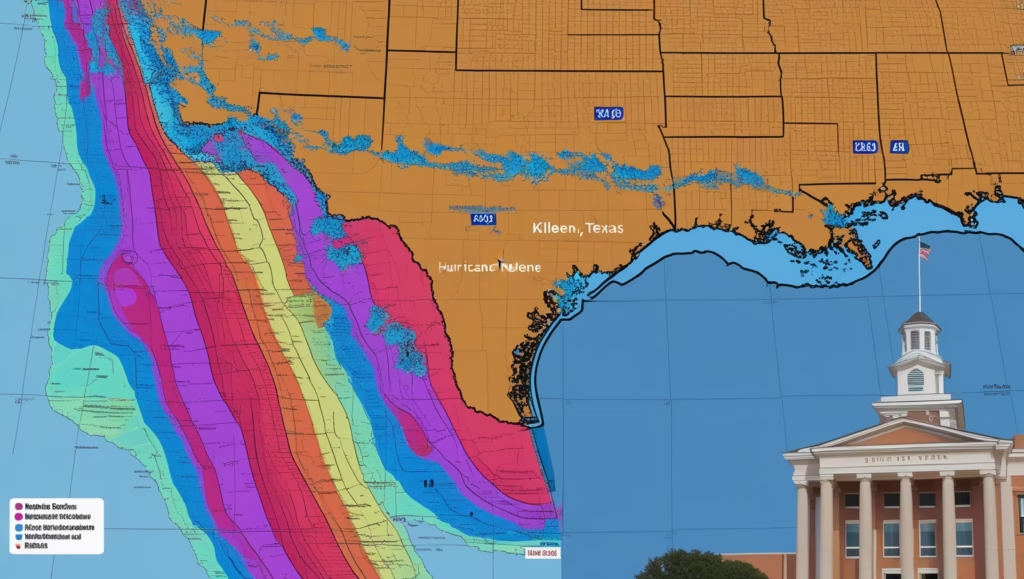Hurricane Helene Update: Formation, Classification, and Trajectory Overview
Formation and Development
Hurricane Helene originated as a tropical depression in the western Caribbean Sea during late September 2024. Initially emerging from a broad, low-pressure system near the Yucatán Peninsula, the disturbance was designated as Potential Tropical Cyclone Nine on September 23. As atmospheric conditions improved—with abundant moisture and warm sea surface temperatures—the system quickly consolidated and was upgraded to Tropical Storm Helene by September 24. This early development stage is typical of tropical cyclones in the Atlantic, where disturbances gain organization and intensify over warm waters.
Classification and Meteorological Characteristics
Helene experienced rapid intensification once it entered the Gulf of Mexico. Enhanced by low wind shear and highly favorable thermodynamic conditions, the storm quickly strengthened from a tropical storm to a full-fledged hurricane by September 25. On September 26, Helene reached Category 4 status on the Saffir–Simpson scale, boasting maximum sustained winds of approximately 140 mph (220 km/h) and a minimum central pressure near 938 millibars.
These meteorological parameters underscore the storm’s potential for catastrophic wind damage, significant storm surge, and extensive flooding. The classification as a Category 4 hurricane places Helene among the most severe systems observed in the 2024 Atlantic hurricane season, highlighting its rapid intensification and destructive capability.
Trajectory, Projected Path, and Timing
Forecast models indicated a northward trajectory for Helene as it tracked from the Caribbean into the Gulf of Mexico. The storm was projected to make landfall in the Florida Big Bend region, near Perry, where coastal communities were placed on high alert. As Helene approached landfall on the evening of September 26, it was expected to bring life‐threatening storm surge, heavy rainfall, and damaging winds to not only Florida but also adjacent areas inland.
Following landfall, Helene rapidly weakened due to increased friction and loss of its oceanic energy source, transitioning to a tropical storm and eventually becoming post-tropical over Tennessee by September 27. The system dissipated by September 29. This projected path and timing prompted emergency declarations across multiple southeastern states and underscored the importance of preparedness against both coastal and inland flooding.
Hurricane Helene: Current Status Update (as of October 1, 2024, 10:00 AM EDT)
Location and Movement
As of the latest update, Hurricane Helene is currently positioned at approximately 33.5°N, 83.0°W, well inland from its initial landfall near Perry, Florida. The system is moving north-northwest at around 12 mph, progressing toward the Tennessee Valley. After its catastrophic impact along the Gulf Coast, Helene’s trajectory has shifted as it encounters increased friction over land and complex terrain. This steady northward movement is characteristic of tropical cyclones that have transitioned from their ocean-fueled intensification phase to a weakening stage over land. Satellite and radar imagery provided by the National Hurricane Center (NHC) confirm that the remnants of Helene continue to travel in a northerly direction, though at a diminished pace compared to its peak intensity.
Intensity and Environmental Influences
At landfall, Helene was a powerful Category 4 hurricane with sustained winds of approximately 140 mph, bolstered by exceptionally warm Gulf waters. However, as the storm advanced inland, it encountered higher levels of wind shear and cooler, drier air. These factors have contributed to a rapid weakening process. Currently, Helene is classified as a tropical depression, with wind speeds now well below tropical storm strength. The significant loss of energy is largely attributed to the interaction with the continental environment, where friction and unstable atmospheric conditions inhibit further intensification. While remnants of Helene still carry substantial moisture and can trigger heavy rainfall, the primary threat of extreme wind damage has substantially diminished.
Warnings and Advisories
Despite the marked decrease in wind intensity, active warnings and advisories remain in effect. The National Hurricane Center, in coordination with local emergency management agencies, has maintained flood watches and storm surge alerts for areas in the Tennessee Valley, western North Carolina, and parts of eastern Tennessee. These alerts emphasize the potential for flash flooding, localized landslides, and sporadic tornadoes generated by residual convective activity. Residents in the affected regions are urged to continue monitoring updates from official sources and adhere strictly to evacuation orders and safety recommendations issued by local authorities. Emergency services remain on high alert, ensuring that any unforeseen developments are promptly addressed.
Hurricane Helene: Impacts and Threats Overview
Affected Areas and Regional Vulnerabilities
Hurricane Helene’s destructive path has extended from the Caribbean islands into the U.S. Southeast. Early in its lifecycle, the storm affected parts of the Yucatán Peninsula and nearby Caribbean nations, while later its trajectory brought significant impacts to Florida’s Big Bend region. As the storm progressed, coastal and inland regions of Georgia, South Carolina, North Carolina, and Tennessee also experienced hazardous conditions. These areas remain particularly vulnerable due to their varying levels of preparedness and differing topographical challenges.
Storm Surge and Coastal Vulnerabilities
One of the most critical threats from Hurricane Helene has been its storm surge. Forecast models predicted surge heights reaching up to 15 feet along Florida’s vulnerable coastal stretches, with some estimates suggesting even higher levels in low-lying areas. The Big Bend region, with its gently sloping beaches and low-lying terrain, is especially susceptible to these surges. Local authorities warned that the incoming surge could inundate coastal communities, damage or destroy infrastructure, and compromise critical evacuation routes.
Heavy Rainfall, Flash Flooding, and Inland Risks
Helene has generated enormous volumes of rainfall, raising significant concerns about flash flooding and river flooding. Meteorologists expect precipitation totals to exceed 10–15 inches in localized areas, particularly where the storm’s rainbands converge. This heavy downpour can lead to rapid rises in rivers and streams, triggering flash floods that pose risks to both urban and rural communities. Additionally, the prolonged rainfall increases the potential for widespread inland flooding, straining drainage systems and emergency services.
Wind Damage and Infrastructure Threats
At its peak, Helene delivered sustained winds of approximately 140 mph, capable of causing extensive structural damage. These winds have the potential to uproot trees, damage roofs, and compromise power lines, leading to widespread power outages across affected regions. The risk to critical infrastructure, including homes, hospitals, and transportation networks, remains significant even as the storm weakens inland.
Tornadoes and Spin-off Severe Weather
Tropical cyclones like Helene often produce spin-off tornadoes within their outer rainbands. These tornadoes, while generally weaker than the primary hurricane, pose additional threats by inflicting localized damage. Areas already burdened by flooding and wind damage are at heightened risk, necessitating continued vigilance and adherence to emergency advisories.
Hurricane Helene: Evacuations and Preparedness
Evacuation Orders: Mandatory vs. Voluntary
In anticipation of Hurricane Helene’s destructive path, local and state officials issued a series of evacuation orders tailored to the specific risk profiles of affected regions. In coastal counties along Florida’s Big Bend—where the threat of a life‐threatening storm surge is highest—mandatory evacuations were enforced. Residents in low-lying and flood-prone areas of Taylor, Dixie, and Wakulla counties were ordered to leave immediately. In contrast, several inland counties across Georgia and North Carolina received voluntary evacuation advisories.
Authorities in these regions emphasized that while residents in floodplains and areas near swollen rivers should consider relocating temporarily, those in safer, higher-ground zones could remain vigilant and prepare for potential rapid weather changes. Such differentiated orders underscore the need to address both the immediate coastal dangers and the secondary impacts, like flash flooding, that can occur further inland.
Shelters: Locations and Capacity
To accommodate the expected influx of evacuees, local governments have pre-designated a network of emergency shelters throughout the affected regions. In Florida’s coastal areas, high-capacity shelters have been set up in community centers, schools, and sports complexes, with facilities capable of housing thousands of residents. For example, large gymnasiums and convention centers in the Big Bend region are equipped with emergency bedding, food supplies, and medical stations.
Similarly, in parts of Georgia and North Carolina, smaller-scale shelters have been activated in municipal buildings and churches, ensuring that displaced residents have safe refuge. Coordination between local agencies and the Federal Emergency Management Agency (FEMA) guarantees that these shelters are staffed with trained personnel, with supplies continually restocked to meet ongoing needs.
Preparedness Tips: Safety Measures for Residents
Residents are strongly encouraged to take proactive steps to safeguard themselves and their property. Essential preparedness tips include assembling an emergency kit that contains critical items such as non-perishable food, bottled water, medications, flashlights with extra batteries, a first aid kit, important documents, and necessary clothing.
Homeowners should secure loose outdoor items, reinforce windows and doors, and ensure that vehicles are filled with fuel. It is equally important for individuals to monitor official weather updates and adhere strictly to local evacuation orders. By following these recommendations and remaining alert through trusted news sources and emergency alerts, communities can better navigate the challenges posed by Hurricane Helene and minimize the overall risk to life and property.
Hurricane Helene: Response and Relief Efforts
Government Actions
In response to Hurricane Helene’s devastation, federal, state, and local governments swiftly mobilized emergency measures. The Federal Emergency Management Agency (FEMA) coordinated with state officials to deploy over 3,200 personnel across the Southeast, providing critical supplies like bottled water, tarps, and Starlink terminals. President Biden approved multiple major disaster declarations for affected states—including Florida, Georgia, North Carolina, South Carolina, Tennessee, and Virginia—unlocking federal funds for both Individual and Public Assistance.
Additionally, state governments, such as North Carolina under Governor Roy Cooper, declared states of emergency to facilitate the rapid deployment of local resources, including the National Guard and emergency operations centers. Local emergency management teams have also activated Disaster Recovery Centers (DRCs) to help residents apply for assistance, repair homes, and restore vital services.
Aid Organizations and NGO Mobilization
Numerous aid organizations have been integral to the relief efforts. The American Red Cross has deployed nearly 1,400 disaster workers, establishing shelters and providing meals to thousands of evacuees. The Salvation Army and All Hands and Hearts have delivered food, water, and critical supplies, while organizations like World Central Kitchen serve hot meals to affected communities. Non-governmental organizations (NGOs) such as Team Rubicon and local volunteer groups have focused on search-and-rescue operations and debris removal. Philanthropic partners, including the Red Cross Disaster Relief Fund and various state-specific relief funds, are also raising millions of dollars to support long-term recovery.
Utility Companies and Power Restoration Plans
Utility companies are a key part of the recovery effort. Major power providers, such as Duke Energy and Tampa Electric, have launched extensive restoration plans to repair damaged substations and restore power to millions of residents. These companies are working around the clock to clear debris, fix damaged infrastructure, and re-establish communication networks. Coordination with federal and state agencies ensures that power restoration efforts are prioritized in areas with the highest need, helping to re-establish normalcy in the hardest-hit communities.
Historical Context: Comparing Hurricane Helene to Past Storms
Similar Paths and Intensities
Hurricane Helene (2024) followed a trajectory through the Gulf of Mexico, making landfall in Florida’s Big Bend region as a Category 4 storm with 140 mph winds. path and intensity are reminiscent of past hurricanes that have traversed the Gulf before impacting the southeastern United States.
Comparison to Hurricane Milton
In contrast, Hurricane Milton (2024) also moved through the Gulf but veered eastward, affecting west-central Florida. While both storms shared initial paths, their differing courses led to varied impacts across the region.
Future Projections for Hurricane Helene
Short-Term Forecast (48–72 Hours)
As of February 4, 2025, Hurricane Helene has dissipated, and no active storm systems are present in the Gulf of Mexico or the southeastern United States. Therefore, there are no forecast models predicting significant weather events in the next 48–72 hours.
Long-Term Potential for Regeneration or Dissipation
Given that Hurricane Helene has already dissipated, there is no potential for its regeneration. The storm’s remnants have been absorbed into the atmosphere, and no conditions are present to support its reformation.
In the absence of new tropical disturbances, the region can anticipate stable weather conditions in the near future.
Conclusion: Community Resilience and Recovery Outlook
Importance of Heeding Warnings and Staying Informed
The devastating impact of Hurricane Helene underscores the critical importance of heeding official warnings and staying informed during severe weather events. Timely information enables individuals and communities to take proactive measures, such as evacuations and securing property, thereby reducing the risk of injury and loss.
Community Resilience and Recovery Outlook
In the aftermath of Hurricane Helene, communities have demonstrated remarkable resilience. Grassroots efforts, such as organizing water delivery and creating makeshift sanitation solutions, highlight the strength of community bonds. For instance, in Asheville, North Carolina, residents crafted rudimentary toilets and coordinated water distribution to address sanitation challenges.
However, the recovery process is complex and ongoing. North Carolina Governor Josh Stein has requested an increase in recovery funds to $1.07 billion, emphasizing the need for immediate action to support businesses, housing, and education.
Additionally, the South Carolina Office of Resilience is collaborating with nonprofits to provide home repair services, demonstrating a coordinated approach to recovery.
While the path to full recovery is challenging, the collective efforts of government agencies, aid organizations, and local communities are paving the way for a more resilient future. Investing in infrastructure, supporting affected populations, and fostering community engagement are essential steps toward rebuilding and strengthening the fabric of these communities.
Stay Updated with USASTIR



